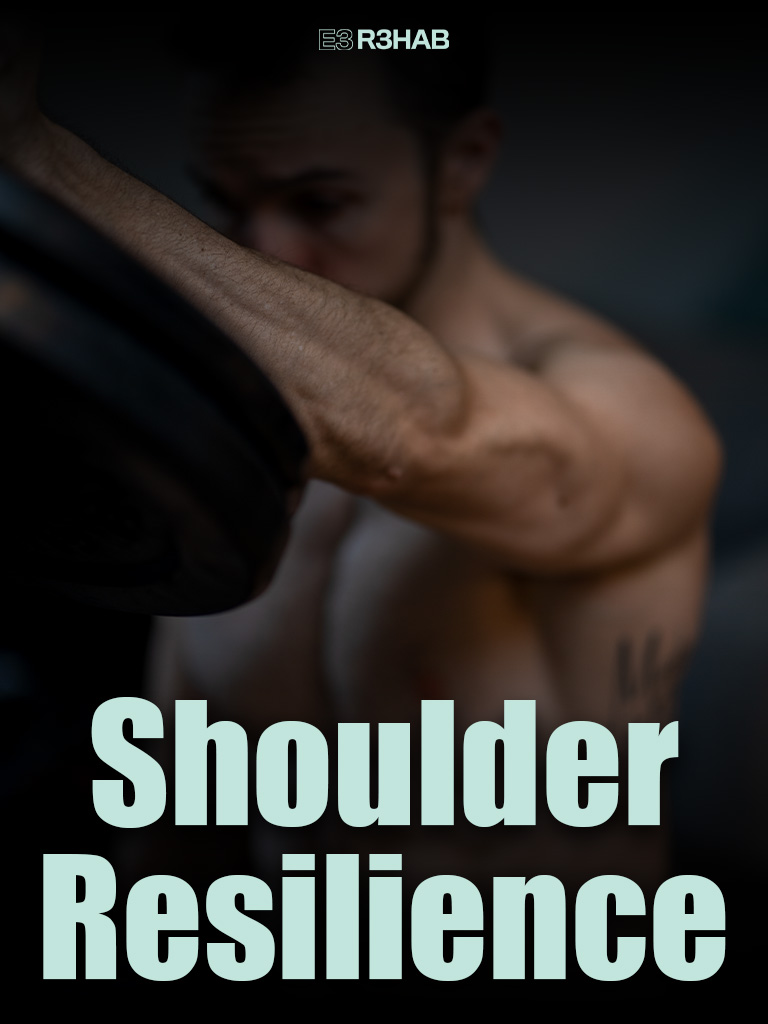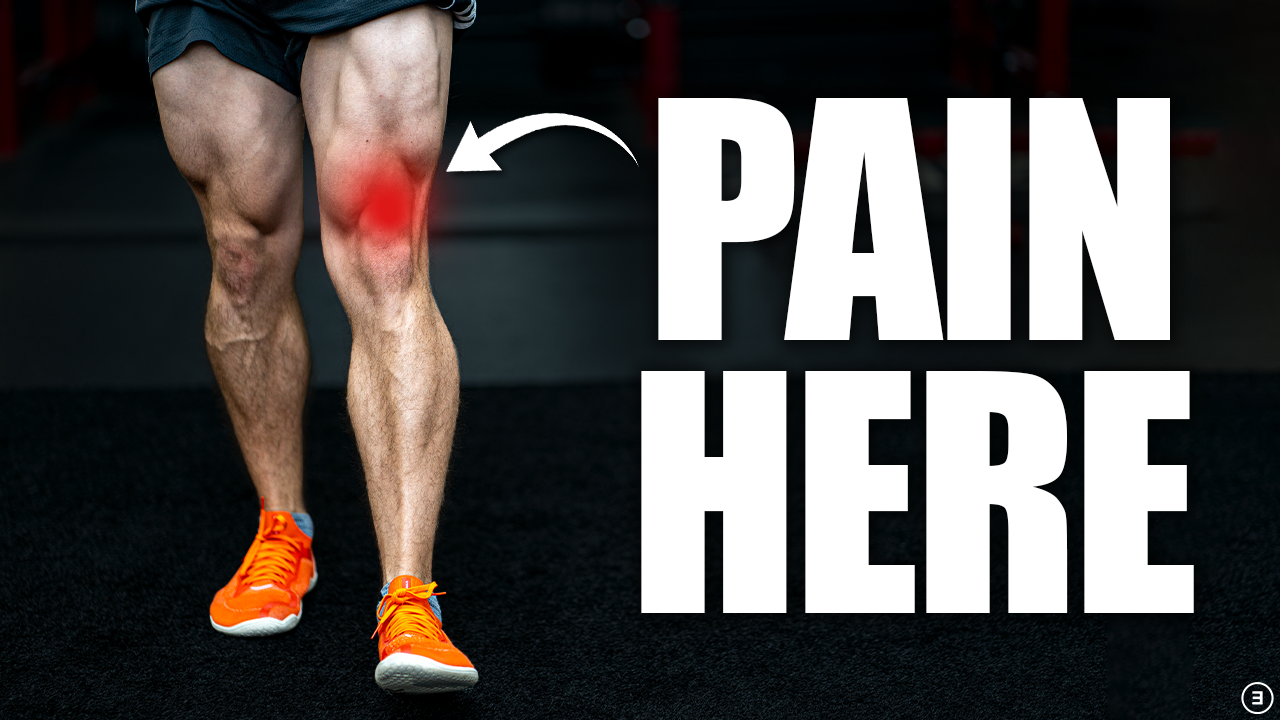In this blog, I am going to discuss 3 ways to train your rotator cuff muscles and provide guidelines for how to program these exercises into your routine.
Looking to improve the strength, range of motion, and control of your shoulders to enhance your function and performance? Check out our Shoulder Resilience program!
What is the Rotator Cuff?
The rotator cuff consists of the supraspinatus, infraspinatus, teres minor, and subscapularis. These originate on your scapula, or shoulder blade, and insert on different parts of your humerus, or upper arm.
As a whole, they provide dynamic stability to the shoulder joint, while individually, they assist with various shoulder movements, including abduction, adduction, internal rotation, and external rotation.
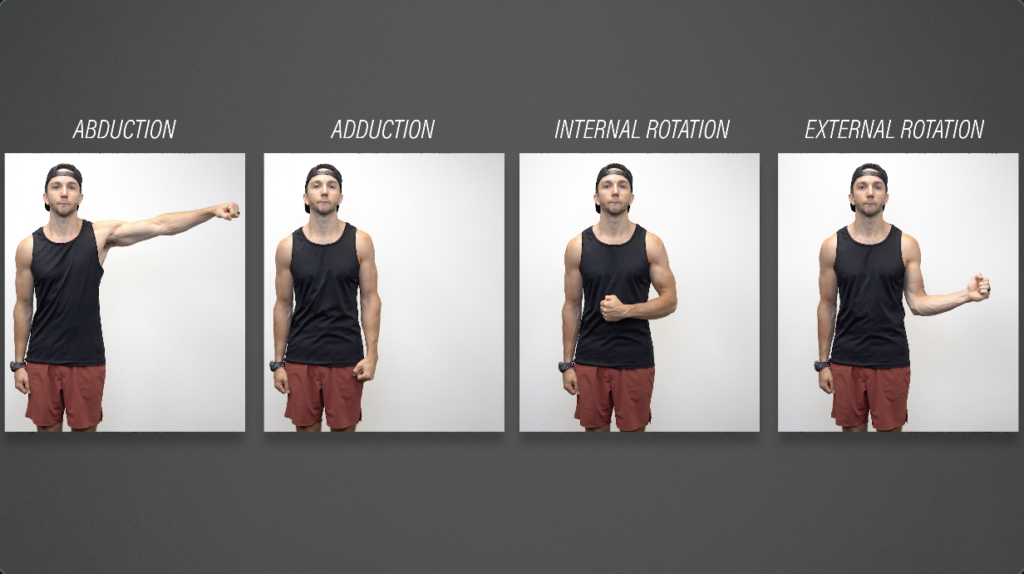
Since these muscles contribute to multiple shoulder movements along with other muscles, you really cannot isolate the rotator cuff. Even with external rotation, which is performed mostly by the infraspinatus and teres minor, you will receive some assistance from the posterior deltoid.
Therefore, in order to maximize rotator cuff strength, my recommendation would be to focus on a comprehensive program. This will better prepare you for a wide variety of tasks and activities involving the shoulder.
To demonstrate what I mean, let’s look at the biceps, since most people are familiar with these muscles. If you perform pull ups and rows, these will secondarily work the biceps, but if your goal was to maximize strength and hypertrophy of these muscles, you would also incorporate isolation exercises, like a biceps curl.
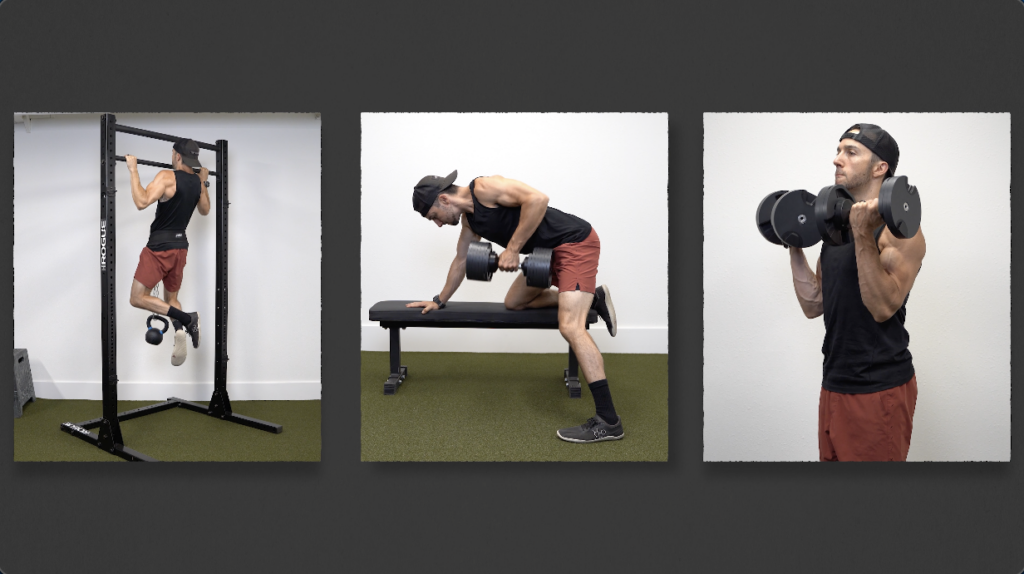
The rotator cuff is no different. Compound pushing and pulling exercises at various angles will activate these muscles, but if you want to train your shoulders to their full potential, a comprehensive program which also includes isolation exercises in different directions will be the most optimal.
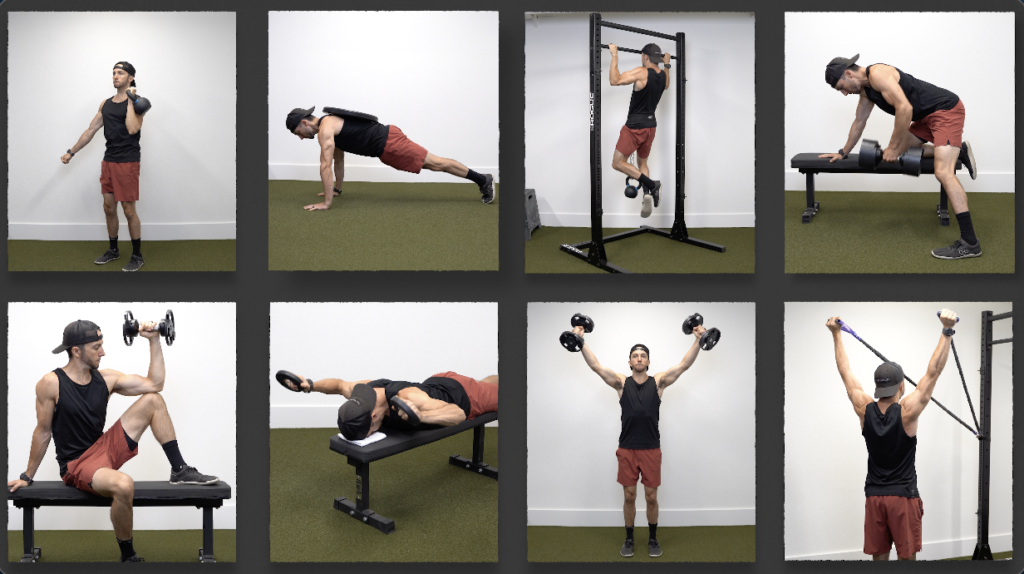
Rotator Cuff Exercises
Here are 3 ways you can train your rotator cuff.
Category #1 – Shoulder Rotation
For external rotation, choose one of the following 4 options.
Option 1 – Side Lying External Rotation. Place your top arm at your side with your elbow bent to 90° and hold a weight in your hand. Rotate your arm outward as far as you can while keeping your arm at your side. Lower back to your stomach and repeat.
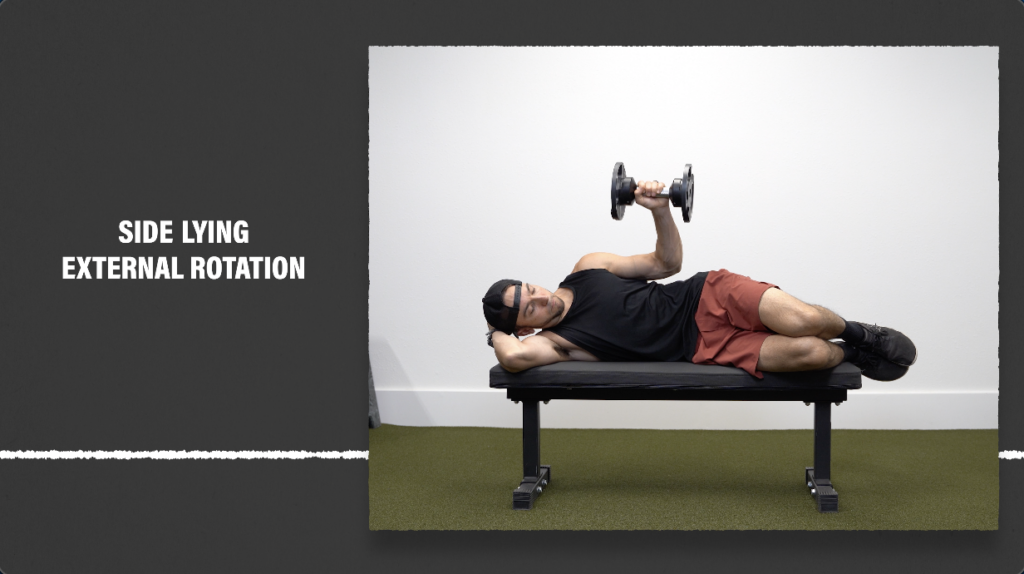
Option 2 – Cable or Band External Rotation. Keep your elbow bent to 90° and rotate outward. Slowly control the motion back to your stomach and then repeat.
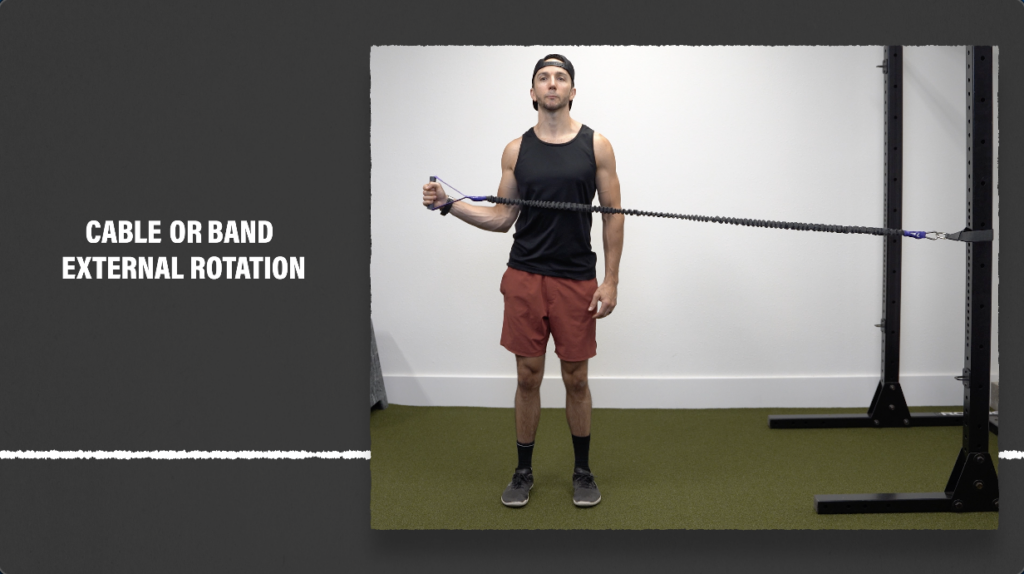
A common mistake with these exercises is moving the upper arm away from the body and extending the elbow, rather than externally rotating the arm. To correct this, you can place a towel under your arm to help maintain the shoulder in a neutral position and facilitate pure external rotation.
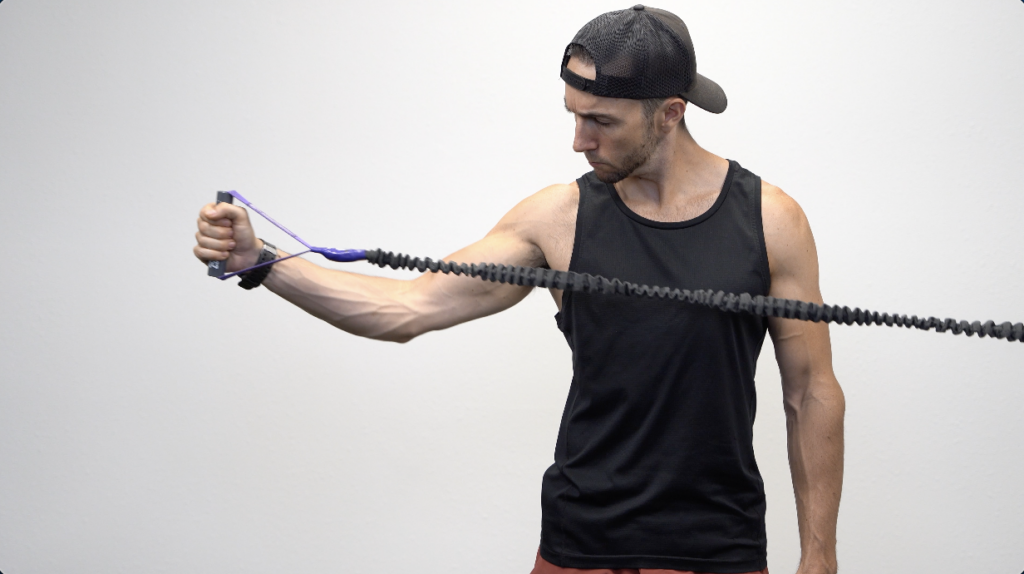
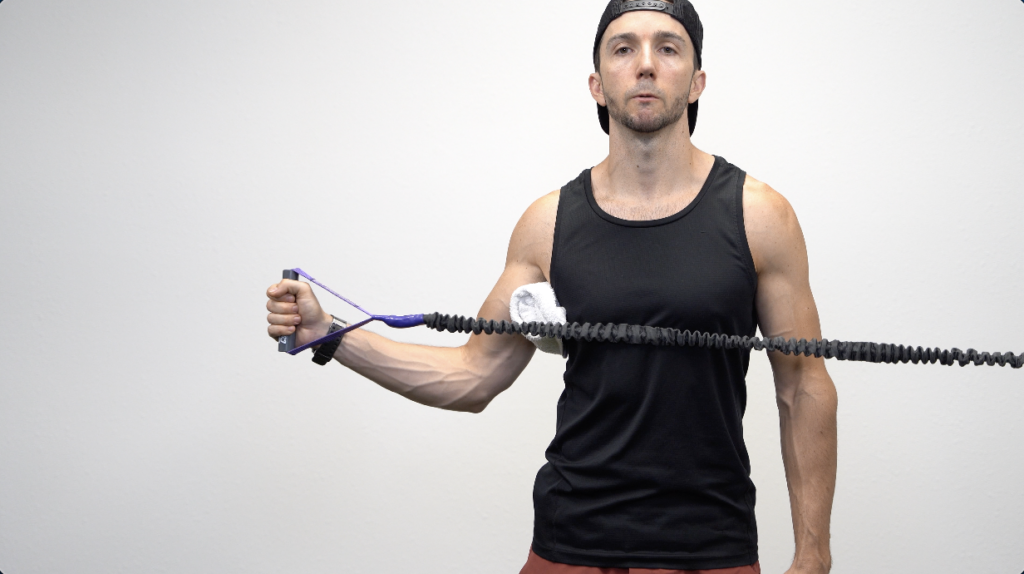
Option 3 – Elbow on Knee External Rotation. Sit with your elbow supported on your knee and a weight in your hand. Slowly lower the weight, rotating your arm inward as far as possible without letting your shoulder roll forward. Then, rotate back to the starting position. In addition to building external rotation strength, this exercise can help improve internal rotation range of motion.
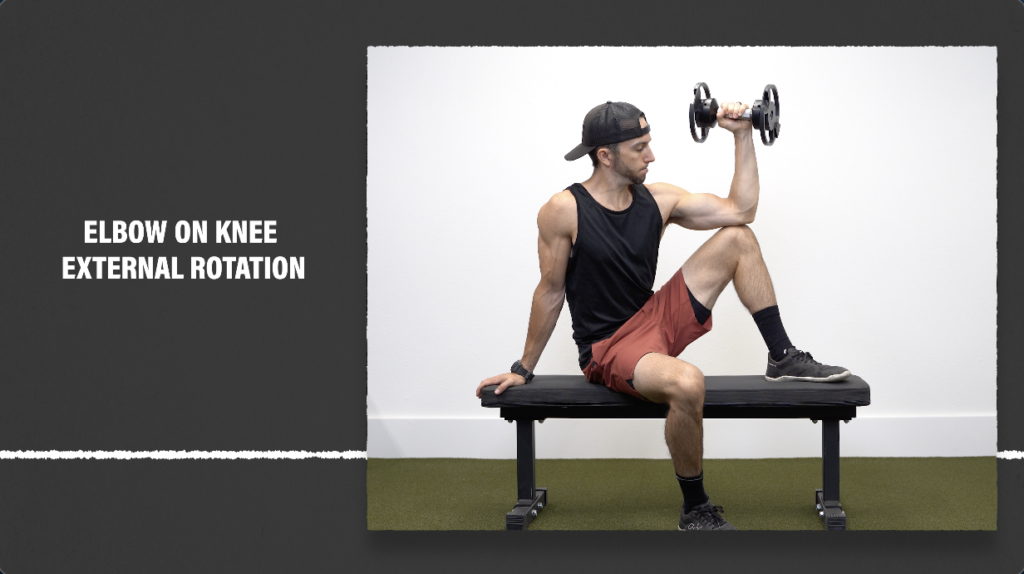
Option 4 – Loop Band External Rotation. With your elbows bent to 90° and pinned at your side , rotate your arms outward, before returning back to the starting position.
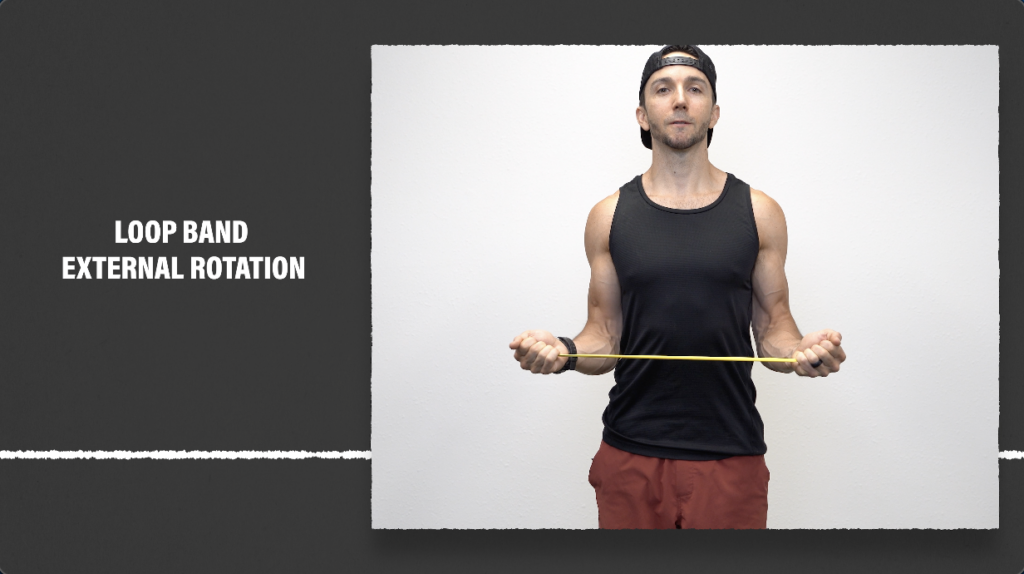
Choose 1 of these 4 options and perform for 3-4 sets of 10-20 challenging repetitions on each arm.
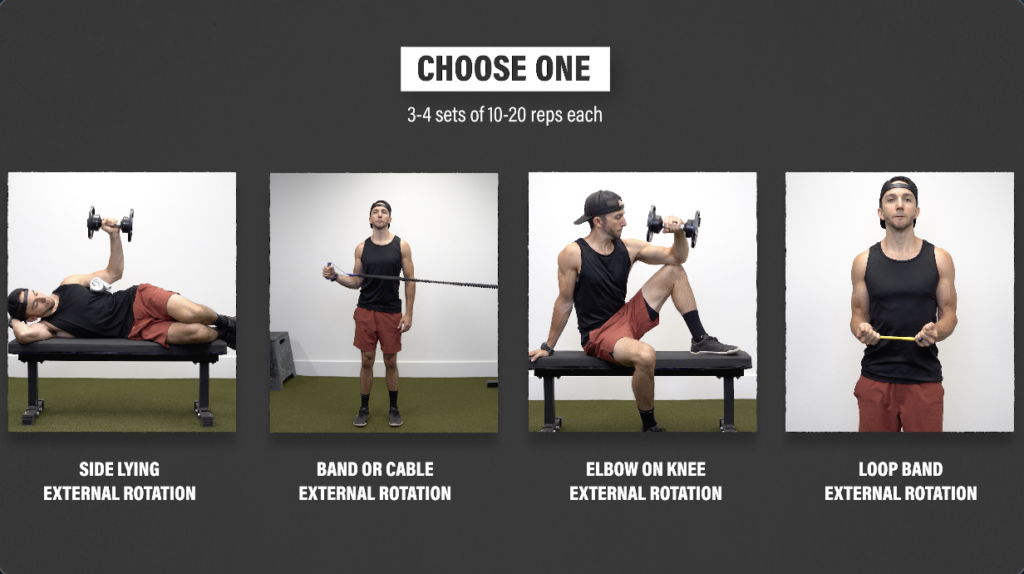
If you participate in sports or activities that involve overhead movements, you may want to consider progressing to variations with the arm in an elevated position. Here are 2 options:
Option 1 – Prone Shoulder External Rotation 90/90. Lie on your stomach on an elevated surface with your upper arms parallel to the ground and elbows bent to 90°. Rotate your arms up toward the ceiling and then rotate back to the start.
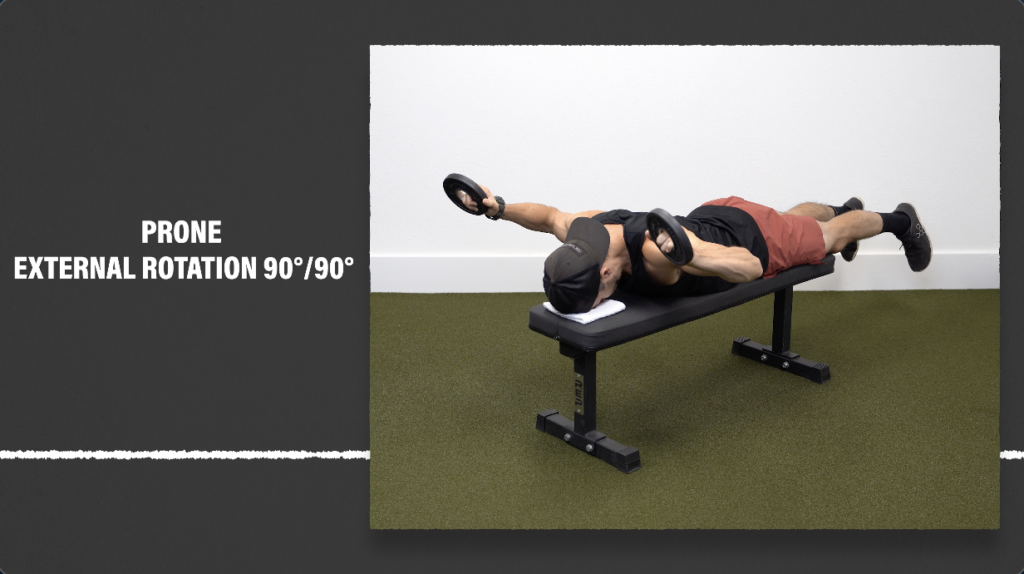
Option 2 – Band or Cable Shoulder External Rotation 90/90. With a cable or band anchored in front of you, keep your upper arm parallel to the ground and elbow bent to 90°. Maintain this position as you rotate in and out of external rotation.

Choose 1 of these 2 options and perform for 3-4 sets of 10-20 challenging repetitions, either with both arms or one arm at a time.
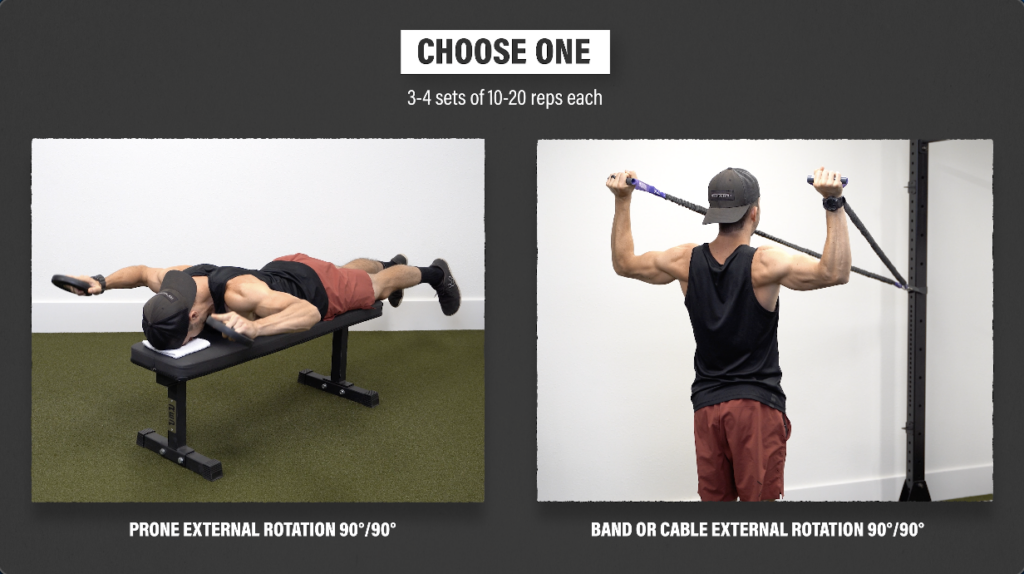
And finally, if you want to emphasize isolated internal rotation strength, the easiest option is using a band or cable in standing. Similar to the external rotation variation, but this time use the arm closest to the anchor point. Keep your arm at your side as you rotate toward your stomach, and then control the motion back to the start. Perform for 3-4 sets of 10-20 repetitions on each side.
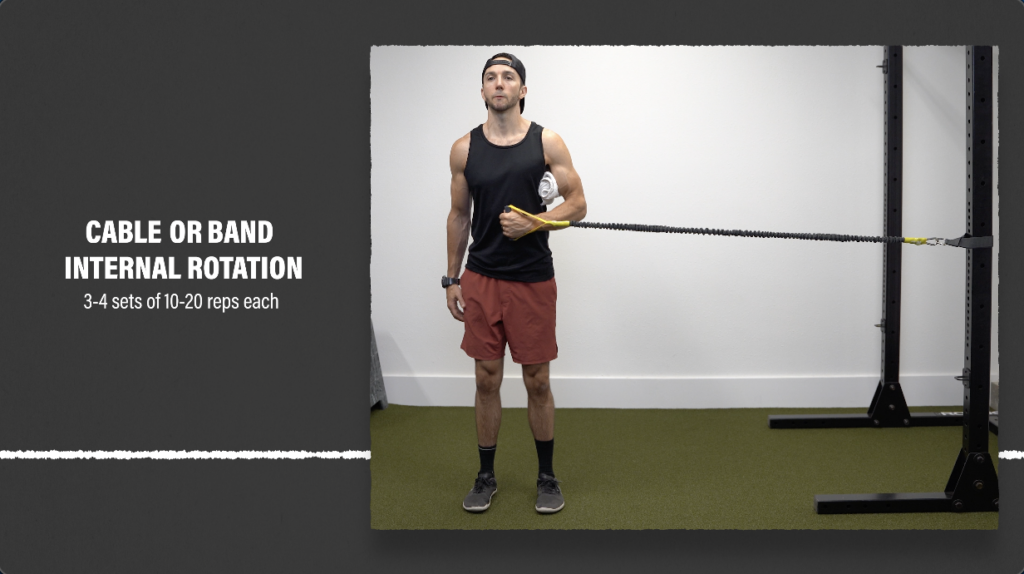
Category #2 – Shoulder Elevation
Here are three progressions:
Progression 1: Angel Progression
Level 1 – Band or Cable A. Keeping elbows straight and palms facing forward, pull a band or cable to your hips, and then control back the start. Repeat for 3 sets of 12-15 repetitions.
Level 2 – Band or Cable T. Pull back until you create a “T” with your arms and trunk. Aim for 3 sets of 12-15 repetitions.
Level 3 – Band or Cable Y. Pull back until you create a “Y” with your arms and trunk. You can keep palms facing forward, or rotate shoulders so your thumbs are facing back. Aim for 3 sets of 12-15 repetitions.
And Level 4 – Banded Angel. Start with your hands at your sides and palms facing forward. Reach overhead and then return back to the start, keeping your elbows straight the entire time. Perform for 3-4 sets of 8–12 repetitions.
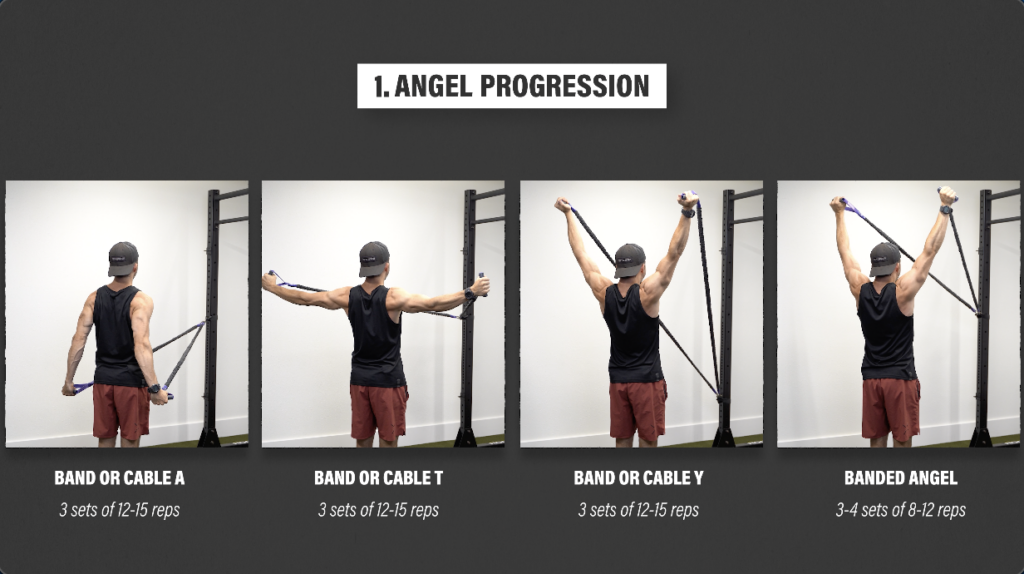
If you don’t have access to a cable or band, you can perform similar movements while lying on your stomach. For levels 1-3, perform on an incline bench or elevated surface either with or without weights. For level 4, perform a prone angel on the floor. Start with hands at your side and palms down. Lift arms up and reach overhead, keeping your elbows straight. For these options, follow the same parameters as before.
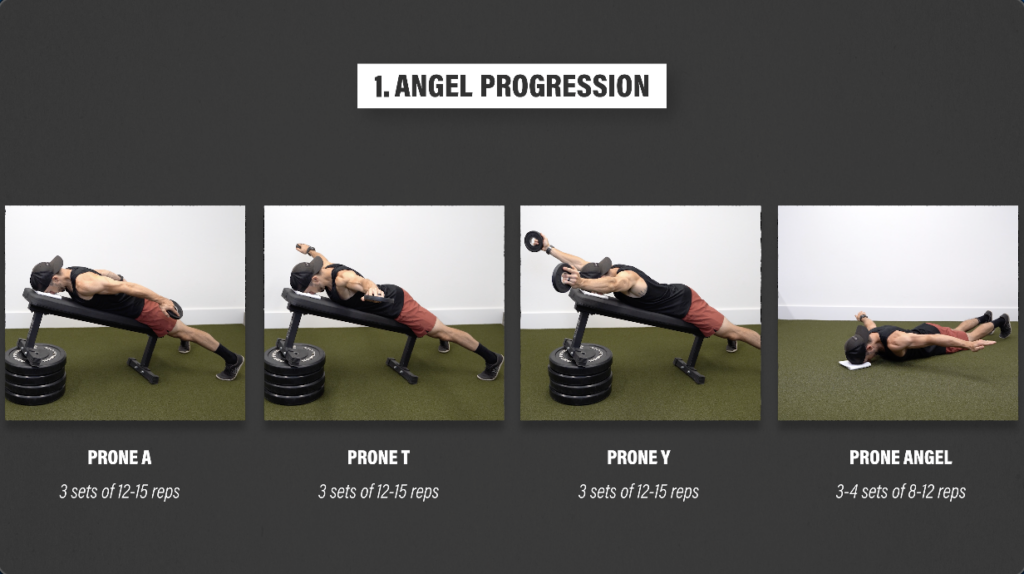
Progression 2: Lateral raise progression.
Level 1 – Lateral Raise to 90°. Keeping your arms relatively straight, raise your arms to about shoulder height. Aim for 3 sets of 12-15 repetitions.
Level 2 – Butterfly Lateral Raise. Start with palms facing the floor, and as you each shoulder height, you are going to externally rotate the arms so thumbs are facing the ceiling. Bring your arms all the way overhead or as high as comfortable, and then return back to the start. Perform for 3-4 sets of 10-15 repetitions.
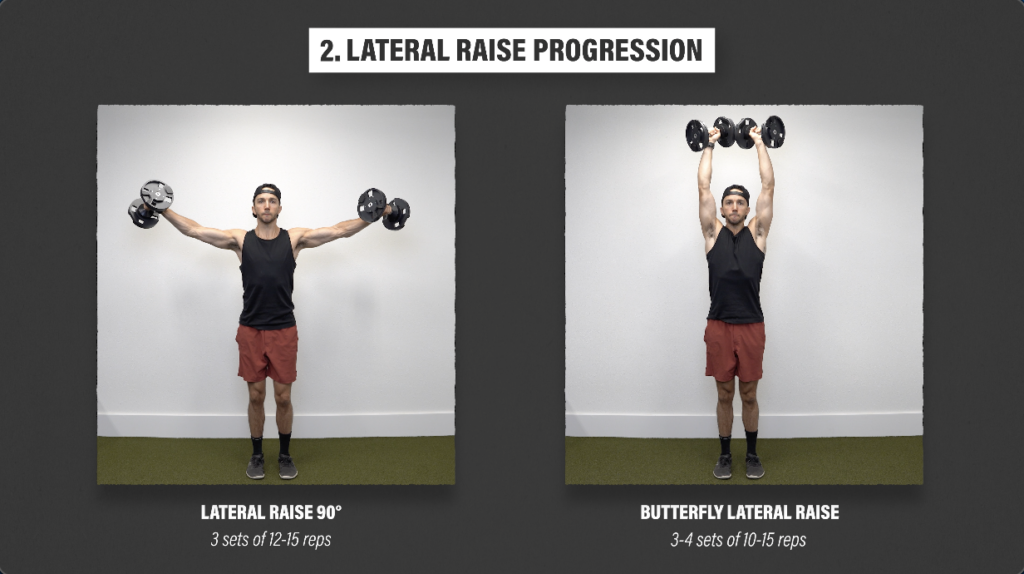
Progression 3: Scaption Progression
Level 1 – Scaption to 90°. With thumbs pointing up, raise your arms to about shoulder height. You are not raising your arms directly to the side or in front of you, but rather an angle in between these two. Aim for 3 sets of 12-15 repetitions.
Level 2 – Scaption to 120°. Same execution but lift your arms slightly higher – to about 120°. Aim for 3 sets of 12-15 repetitions.
Level 3 – Scaption Overhead. Bring your arms fully overhead and then slowly lower back down. Perform for 3-4 sets of 10-15 repetitions.
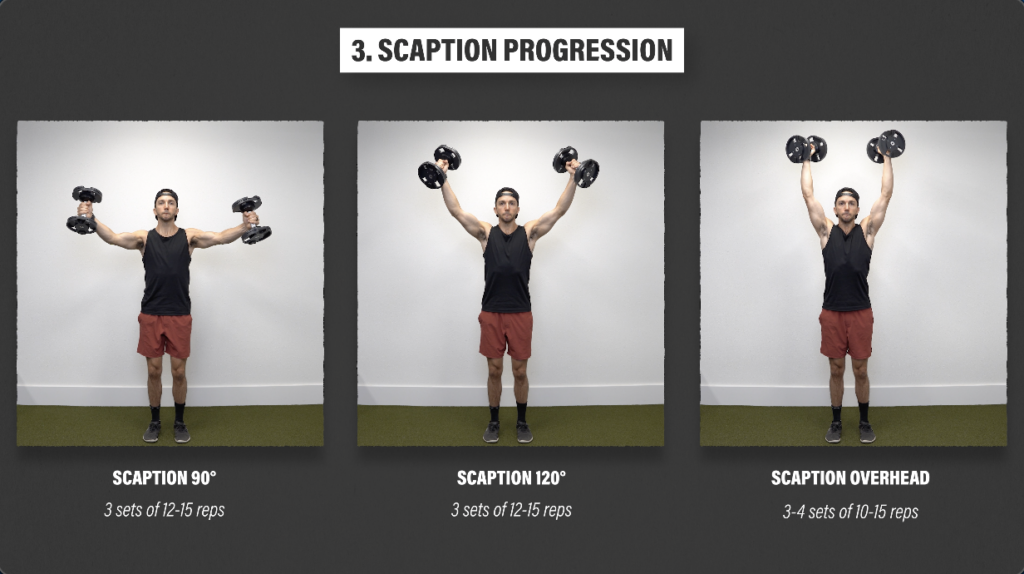
If you don’t have access to dumbbells, you can also perform the lateral raise or scaption progression with a band.
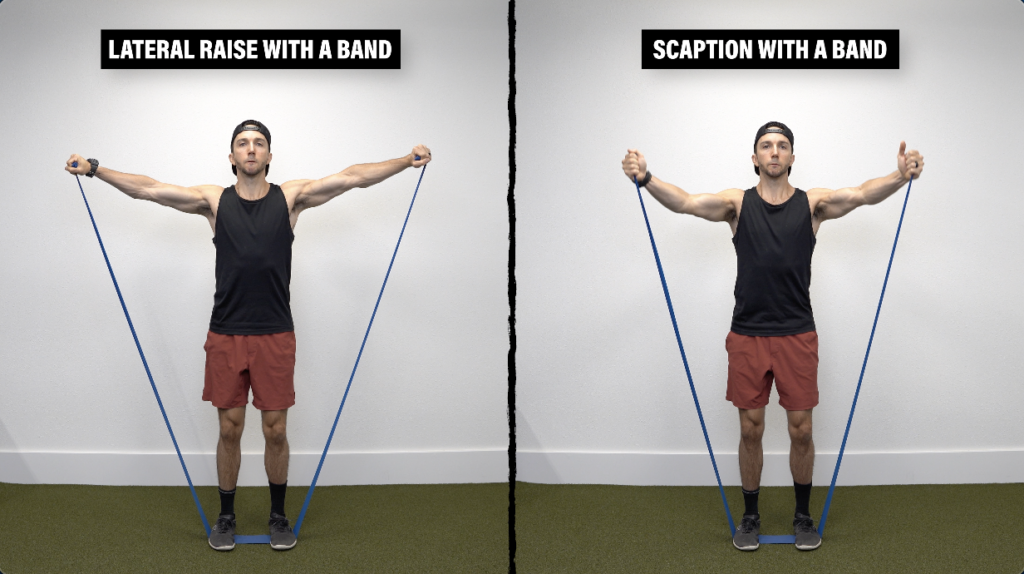
Other alternatives include using a cable column or a loop band.
For the cable column, you can cross it in front or behind you, or you can try a leaning variation with the cable between your legs.
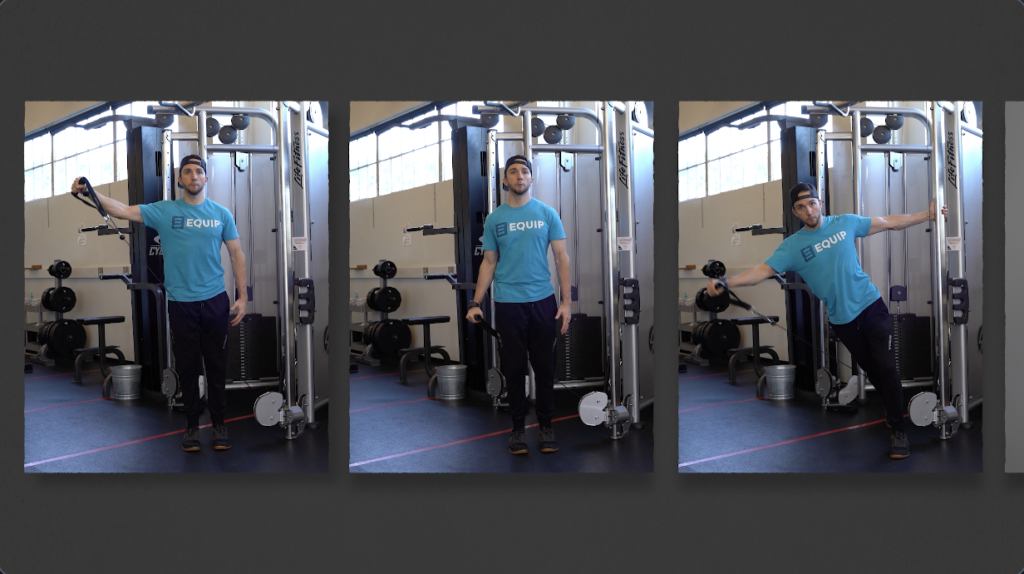
For the loop band, place the band around your wrist and either perform shoulder abduction for repetitions or you can hold for time.
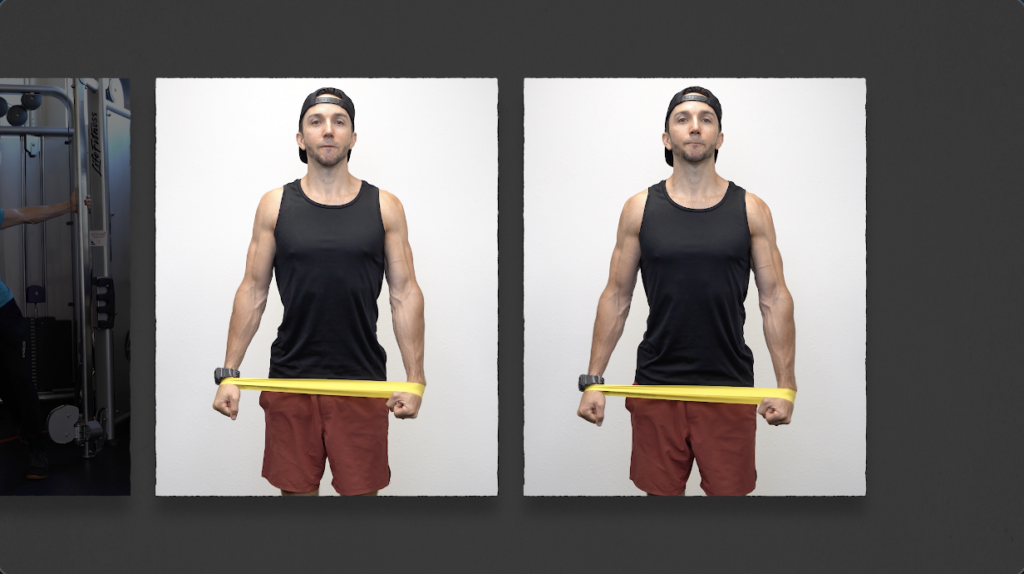
Category #3 – Compound Exercises
This involves pushing and pulling movements at various angles. There are endless options to choose from, but here are four suggestions.
Option 1 – Push-up. Start with bodyweight push ups from the floor. If these are too challenging, elevate your hands on a bench. If these are too easy, place a weight on your back. Perform 3-4 sets while moving through your full range of motion during each repetition.
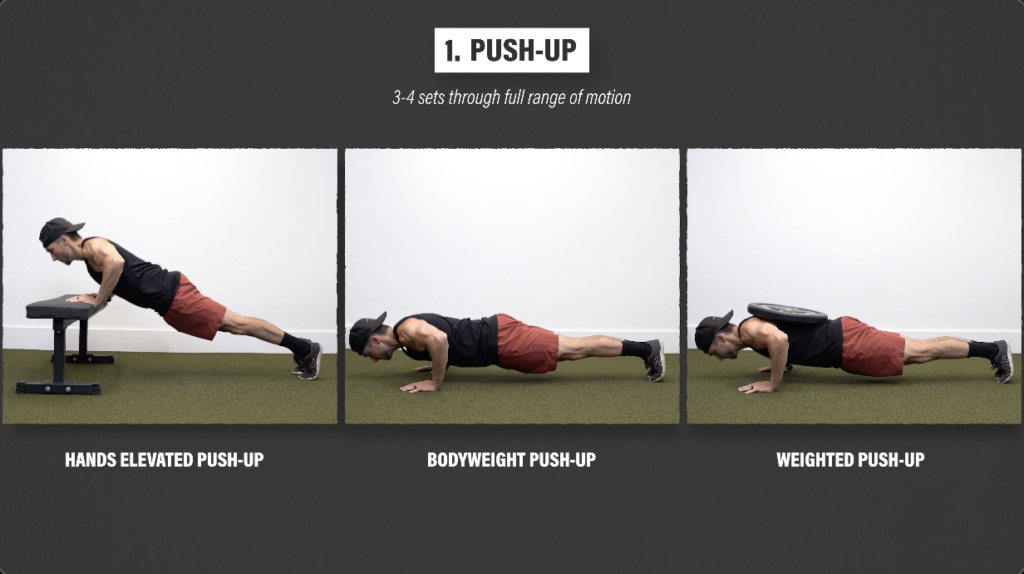
Option 2 – Overhead Press. Use a barbell, dumbbell, or kettlebell. If you want to further challenge your shoulder proprioception, try a half kneeling bottoms up kettlebell press. Hold a kettlebell upside down and press from the same side as the “down” leg. Perform for 3-4 sets of 6-12 repetitions on each arm.
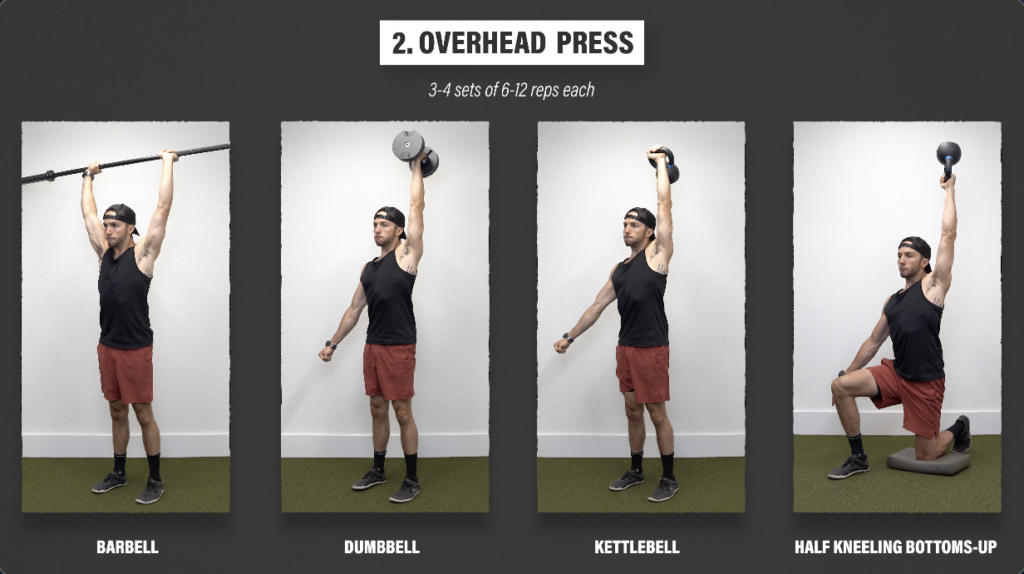
Option 3 – Inverted Row. You can use a TRX or a barbell set up in a rack. The more horizontal you are, the harder it is, and the more vertical you are, the easier it is. Find an angle that you can perform for 3-4 sets of 10-15 challenging repetitions.

Option 4 – Pull-up. Your goal is a controlled pull up through your full range of motion. This means chin above the bar at the top, and elbows straight at the bottom. If body weight is too- hard, perform an assisted variation with a band or a machine. If body weight is too easy, add weight.

Programming Rotator Cuff Exercises
For programming, here is an example of a 2 day routine:
On Monday and Thursday, you will perform a superset of pull ups and push ups, followed by a superset of an overhead press and inverted rows. Then to finish the session, you will do lateral raises and the banded external rotation one day, and prone angels and banded external rotation on the other.
You can perform the exercises on whatever days best fit your schedule, but just make sure you rest at least one day in between workouts to allow for adequate recovery.
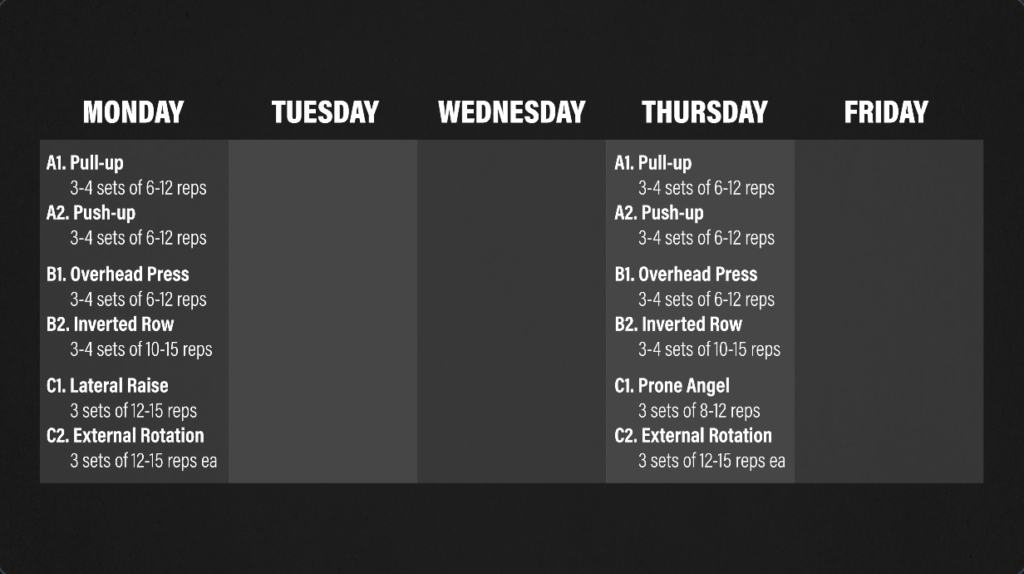
Finally, in order to maximize performance, implement these for a minimum of 12 weeks, progressing exercises, weight, and effort as tolerated.
Rotator Cuff Exercises Summary
In summary, the rotator cuff provides dynamic stability to the shoulder joint and contributes to multiple shoulder movements, however you cannot fully isolate these muscles. Therefore, to maximize rehab or performance, my recommendation would be to utilize a comprehensive program that targets the entire shoulder with both compound and isolation exercises in various directions.
Performing these exercises 2-3 times a week, for a minimum of 12 weeks, will increase your strength, build your overall capacity, and help adequately prepare you for daily tasks, the specific demands of your desired activity, or whatever else life throws at you.
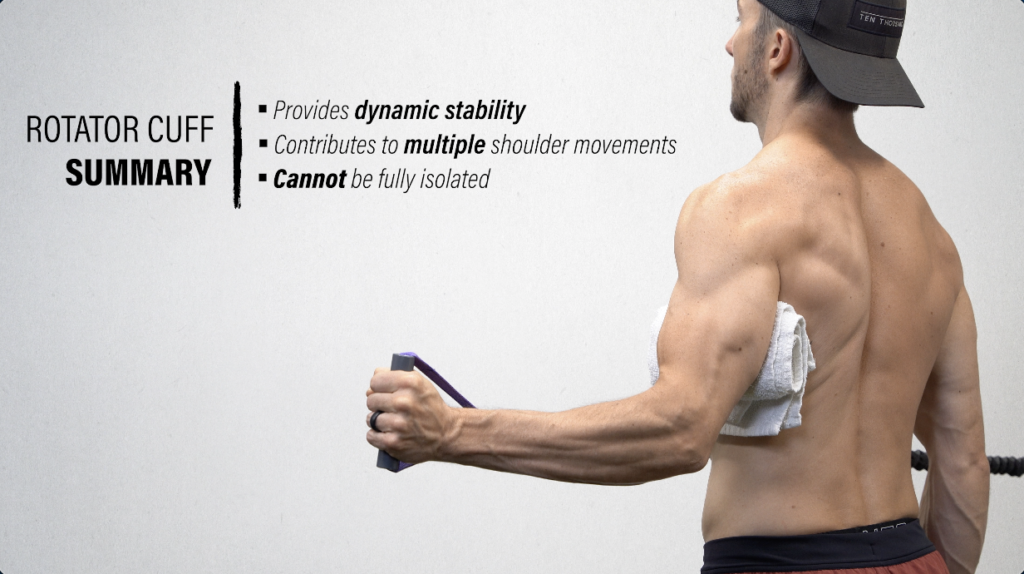
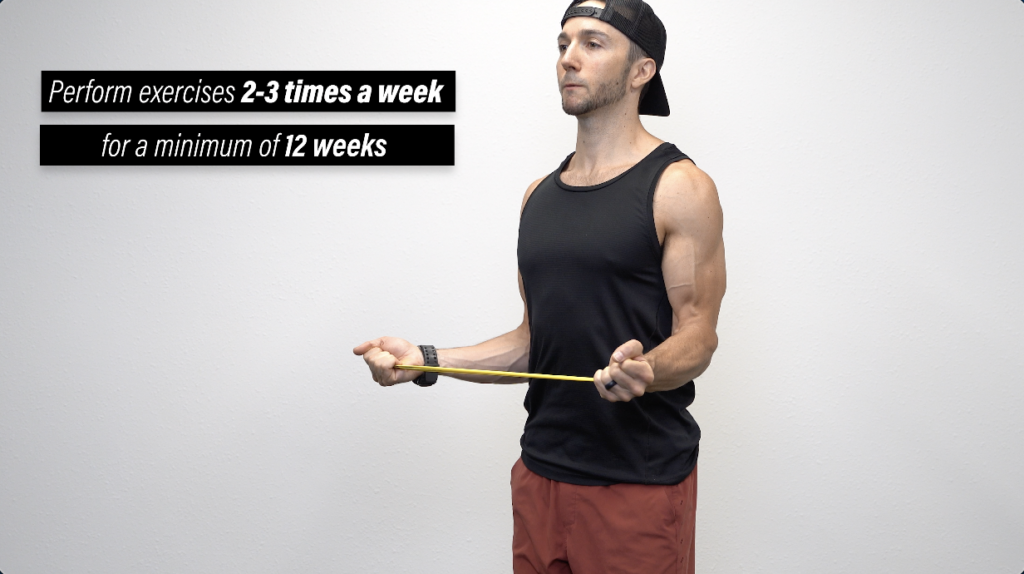
Don’t forget to check out our Shoulder Resilience Program!
Open vs Closed-Chain Exercises, Exercises for Neck and Shoulder Pain, Frozen Shoulder
Thanks for reading. Check out the video and please leave any questions or comments below.



